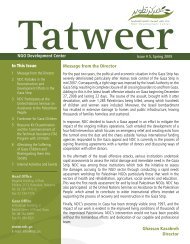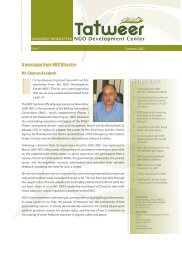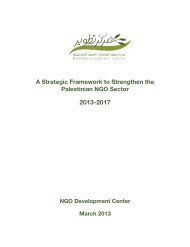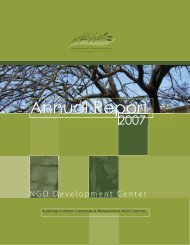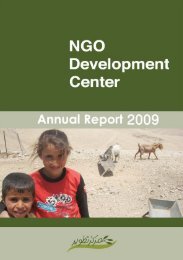Tracking External Donor Funding.pdf - NDC
Tracking External Donor Funding.pdf - NDC
Tracking External Donor Funding.pdf - NDC
Create successful ePaper yourself
Turn your PDF publications into a flip-book with our unique Google optimized e-Paper software.
Governmental <strong>Donor</strong>s<br />
As discussed in the previous sections, decreases in<br />
governmental aid to PNGOs runs in parallel to an<br />
increase in PNGO partnerships with multilateral<br />
agencies. During the period of the Intifada for example,<br />
multilateral aid to PNGOs comprises around ¾ of total<br />
governmental aid, as opposed to only around ¼ in<br />
2008.<br />
Figure 20: Governmental versus Nongovernmental<br />
<strong>Donor</strong>s as a Percentage of PNGOs’ <strong>External</strong><br />
Revenues (1999 – 2008)<br />
70%<br />
60%<br />
50%<br />
40%<br />
30%<br />
20%<br />
10%<br />
0%<br />
1999 2000 2001 2002 2003 2004 2005 2006 2007 2008<br />
Governmental Non Govermental Multilateral<br />
Source: MAS, 2009 – PNGO Survey<br />
3.6 <strong>Tracking</strong> <strong>External</strong> <strong>Funding</strong> to PNGOs by<br />
Sector and Sector Grouping<br />
3.6.1 Distribution of PNGOs by Sector<br />
MAS mappings of the PNGO population in 1999 and<br />
2006 revealed what activity sectors PNGOs are engaged<br />
in. figure 21 shows both the growth in the number of<br />
PNGOs as a whole, as well as the shift among sectors.<br />
The sectors that saw the most dramatic growth between<br />
1999 and 2006 were Charity and Relief, Family<br />
Planning, Liberal Arts Education, Rural Development,<br />
Health, Vocational Training, Democracy Promotion and<br />
Women’s Affairs. All of these sectors at least doubled<br />
the number of NGOs working in them, within an overall<br />
65% growth in the number of PNGOs between 1999 and<br />
2006. The sectors of Disabled Care, Scientific Education,<br />
and Human Rights all saw more moderate growth in the<br />
numbers of PNGOs working in them.<br />
Given the overall growth of PNGOs, it is not surprising<br />
that relatively few sectors saw a decline. The fact that<br />
some do decline, however, signals a clear difference in<br />
priorities between the two cross-sectional snapshots.<br />
According to our mappings, the sectors of Children’s<br />
Activities, Elderly Care, Water & Environment,<br />
Research, Religious Activities, Youth & Sports and<br />
‘Others’ all saw a decline in the number of PNGOs<br />
identifying them as their primary activity between 1999<br />
and 2006.<br />
35


